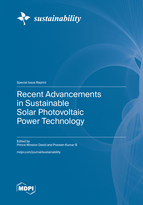Recent Advancements in Sustainable Solar Photovoltaic Power Technology
A special issue of Sustainability (ISSN 2071-1050). This special issue belongs to the section "Energy Sustainability".
Deadline for manuscript submissions: closed (30 July 2023) | Viewed by 20000
Special Issue Editors
Interests: renewable energy; solar PV systems; power drives
Special Issue Information
Dear Colleagues,
It is our pleasure to announce a new Special Issue in the journal Sustainability: “Recent Advancements in Sustainable Solar Photovoltaic Power Technology”.
Energy plays a decisive role in realizing the Sustainable Development Goals (SDGs), such as employment growth, industry, innovation, and infrastructure, sustainable cities and communities, clean energy, and climate change. Moreover, solar energy has huge potential as a source of electricity, space heating and cooling, water heating, energy storage, solar cooking, drying, distillation, industrial process heat, and much more. This Special Issue aims to provide a platform with which researchers may present new research findings as well as reviews of significant work in the field of solar photovoltaic systems and critical issues in solar power generation technology. We are particularly interested in papers presenting the latest achievements and current problems in solar power generation technology and proposing corresponding solutions to key technical challenges in the utilization of solar power, pointing out future directions for the sustainable development of solar power generation technology.
Original research articles and reviews are welcome. Research areas may include (but are not limited to) the following:
- Modeling, simulation, optimization, and performance assessment of sustainable solar technologies
- Environmental impacts, social aspects, policy, and economic aspects of sustainable solar technologies
- Energy storage technologies
- Solar based Hybrid PV/T systems
- Floating solar plants
- Solar in Agriculture
- End of Life cycle and Circular Economy of sustainable solar systems
- Solar applications in buildings
- Maximum power point tracking techniques
- Reconfiguration of solar PV system
- Parameter estimation of PV cells
We look forward to receiving your contributions.
Prof. Dr. Prince Winston David
Dr. Praveen Kumar Balachandran
Guest Editors
Manuscript Submission Information
Manuscripts should be submitted online at www.mdpi.com by registering and logging in to this website. Once you are registered, click here to go to the submission form. Manuscripts can be submitted until the deadline. All submissions that pass pre-check are peer-reviewed. Accepted papers will be published continuously in the journal (as soon as accepted) and will be listed together on the special issue website. Research articles, review articles as well as short communications are invited. For planned papers, a title and short abstract (about 100 words) can be sent to the Editorial Office for announcement on this website.
Submitted manuscripts should not have been published previously, nor be under consideration for publication elsewhere (except conference proceedings papers). All manuscripts are thoroughly refereed through a single-blind peer-review process. A guide for authors and other relevant information for submission of manuscripts is available on the Instructions for Authors page. Sustainability is an international peer-reviewed open access semimonthly journal published by MDPI.
Please visit the Instructions for Authors page before submitting a manuscript. The Article Processing Charge (APC) for publication in this open access journal is 2400 CHF (Swiss Francs). Submitted papers should be well formatted and use good English. Authors may use MDPI's English editing service prior to publication or during author revisions.
Keywords
- solar energy
- DC– DC converters
- MPPT
- solar PV
- energy storage
- demand-side response
- building-integrated photovoltaics
- partial shading in photovoltaic systems
- design, modeling and optimization
- parameter estimation
- reconfiguration







